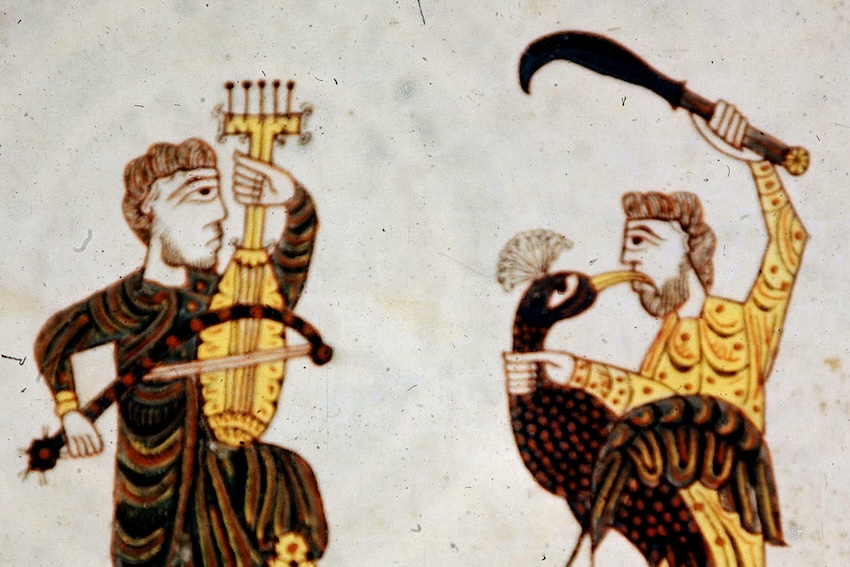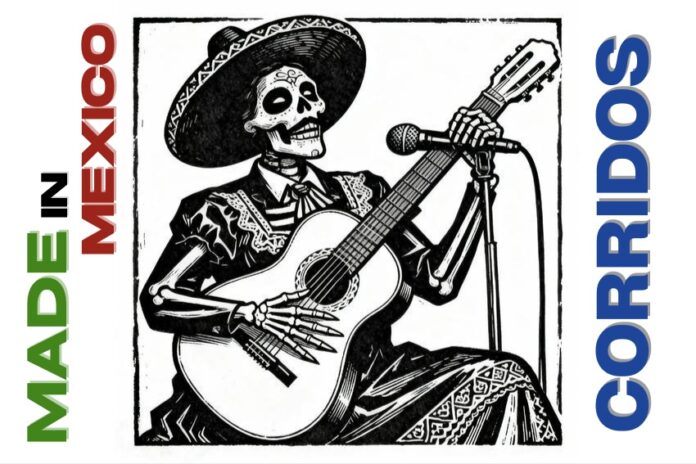Talking about music and the effect it has on humans is complex. Music shapes brains and communities: it forges neural connections, helps regulate emotion and offers a language for belonging. The corrido — Mexico’s narrative ballad — embodies all those powers. It has been a walking newspaper, a moral pamphlet, a protest song, and, increasingly, a contested cultural weapon. So why does the Mexican state practice a veiled censorship of this genre today, and what does the corrido tell us about modern Mexico?
Jugglers and corridos
To find the corrido’s origin, we must look to medieval jugglers. Before newspapers and radio, itinerant narrators moved from town to town, recounting events and epics with a vihuela, a precursor to the guitar. That practice evolved into the Spanish romancero of the 15th and 16th centuries: eight-syllable verses delivering current events in a direct, emotional tone. Some scholars trace a specific Andalusian strain — marked by a “correntío” or accelerated rhythm — as a key progenitor.

Arriving in New Spain, the romancero did not remain pure. It fused with Indigenous oral forms and Afrodescendant rhythms, folding pre-Hispanic narrative techniques into a hybrid vernacular that became uniquely Mexican. In Northern Mexico, a further infusion came from German, Swiss and Austro-Hungarian immigrants who introduced polkas, mazurkas, redovas, the violin and the accordion.
The guitar, bajo sexto, accordion, and polka and waltz-derived meters together formed the musical DNA that allowed Spanish-inflected corridos to evolve into the Northern Mexican styles now among the genre’s most recognizable variants.
The 19th-century corridos
Under Porfirio Díaz, European refinement was idealized. As a result, the corrido became a popular countervoice. In a mostly illiterate society, corridos functioned as both information and entertainment — often carrying clear moral lessons. They narrated land disputes, banditry, and local injustices in compact, episodic verses that crystallized communal memory.
The corrido of Heraclio Bernal (circa 1870–1880) exemplifies this. Bernal — cast as a bandit and a kind of proto Robin Hood who opposed Díaz’s order — was immortalized in song as a brave, authentic figure unafraid of death. Contemporary corridos were pamphlets set to music: instruments of social critique and folk memory.
Revolutionary corridos (1910–1920)
During the Mexican Revolution, the corrido flourished. Thousands of ballads recounted the deeds and deaths of Emiliano Zapata, Pancho Villa, Francisco I. Madero, Venustiano Carranza and countless local actors. Corridos appeared in newspapers and on loose broadsheets advertised as “new corridos,” and for many they were a primary source of news.
But the songs did more than report events: they authorized new imaginaries. Much as muralists refigured the nation — elevating peasants and laborers into civic icons — the corrido became the musical narrative of rural life, a sonic repository of popular values. La Adelita, Valentina, the Corrido de la Toma de Zacatecas, and an adapted La Cucaracha (used to lampoon President Victoriano Huerta) entered a shared cultural lexicon that helped legitimate postrevolutionary ideologies.
1930–1960
After the Revolution, Mexico experienced a profound transformation in its political, social and demographic landscape. Urban centers — especially Mexico City — began to attract large numbers of newcomers lured by promises of modernity and a better future, fueling rapid city growth and social change. At the same time, rural Mexico acquired a romantic-epic image, with inhabitants stereotyped as “rough, direct, uncivilized, but kind-hearted.” This dual narrative — that of proud countryside and modern city — would shape Mexico’s cultural landscape for decades.
In both music and cinema, rural people were portrayed as humble yet proud, embodying virtues that contrasted with urban sophistication but also contributed to a shared national identity. To legitimize this collective vision, the Mexican state deployed culture as a tool of consolidation: literature, cinema, theater and especially radio were used to craft and disseminate a unified image of Mexico. Corridos, alongside genres such as huapango, banda, sones and rancheras, transitioned from local, fiery oral traditions into part of a broader, state-backed cultural repertoire — an effort to forge a common cultural fabric across regional boundaries.
This period also marks the emergence of the first narcocorridos, even as they continued to contain cautionary messages. The earliest recorded narcocorrido, El Pablote (1931), tells of Pablo González, known as “The Morphine King,” and functions primarily as a warning: emphasizing the tragic, often deadly consequences of criminal life rather than glorifying the outlaw. Unlike the narcocorridos of later years, which would celebrate criminal figures and their deeds, these early songs served to dissuade people from following in such dangerous paths. As radio and cinema standardized and disseminated these songs, local variations and rough edges of regional narratives were smoothed, turning them into a national storytelling tradition — yet still rooted in the social realities of marginalized communities.
1960–1980
By the late 1950s, many regarded the corrido as folklore in decline — a nostalgic but dated taste of Mexican peasantry gone by. Themes shifted toward migration, identity and the reality of drug trafficking. The late 1980s brought a pivotal rupture in the figure of Chalino Sánchez. His unpolished delivery and raw narrative aesthetic cut through studio gloss; he popularized the practice of composing commissioned corridos for criminal figures and, crucially, normalized a celebratory tone toward illicit actors. That normalization carried risks — several singers and composers of the time paid with their lives.
Infamously, Sánchez is said to have been handed a note before performing his final song, informing him that he would be executed at the conclusion of his concert. A video of him receiving and reading the note, before launching into a spirited final performance, has become an important part of Mexican folklore. Regardless of the contents of the note, Sánchez was shot and killed immediately after leaving the stage.
2008 and the ‘altered corrido’
President Felipe Calderón’s militarized offensive against cartels in the late 2000s altered the cultural ecology. Corridos evolved from chronicling social life to entering criminal ecosystems. New singers — sometimes commissioned by cartels, sometimes seeking notoriety — produced explicit songs that described organizational structures, operations, and personalities. In some regions, corridos functioned as targeted messages among rival groups or as status instruments within criminal networks.
Chalino Sánchez - Alma Enamorada (En Vivo) Video Oficial con Letras
Mainstream radio and public venues — conscious of safety and reputation — began to restrict such songs. The state framed these restrictions as public safety measures: songs that normalize criminality can arguably promote recruitment or confer legitimacy on violent actors. Yet the evidence for direct causality is weak; cultural products shape imaginaries but do not by themselves produce armed actors. What bans often achieve is displacement: corridos migrate to pirate radio, local stations and online platforms where they can become more clandestine and, in some cases, operational.
New media and corridos
Digital platforms have proven more permissive than traditional broadcasters. Streaming, social networks and video sites have decentralized control, allowing subgenres to proliferate and cross borders. Corridos tumbados — a hybrid of trap, hiphop cadence, autotune and corrido storytelling — illustrates the genre’s current elasticity. It speaks to urban youth experiences of identity, marginalization and aspiration.
The growth of his genre, and major singers Natanael Cano, Junior H, Fuerza Regida, and Peso Pluma, reflects Mexico’s continuing appetite for corridos — more specifically, narcocorridos. Peso Pluma’s appearance on the Jimmy Fallon show in 2024 represented the moment at which the genre became mainstream among not only Northern Mexicans but also younger Mexican-Americans on the other side of the border.
Beyond the obvious parallels to urban music genres in the United States, their success underscores a deeper truth: in a country of nearly 130 million, stark economic inequality (INEGI figures show only about 1.2 percent in the upper class while 56.6 percent fall into lower brackets) makes narratives of rapid ascent and alternative forms of capital especially resonant.
Do corridos cause violence?
The government’s justification for restricting corrido broadcasts is straightforward: songs that glorify crime can normalize and celebrate violence. Cultural expressions do shape worldviews. But violence has multiple and deeper causes — poverty, impunity, institutional weakness, and the lucrative rewards of illegal markets. To treat songs as primary causal agents is naive. Moreover, suppression can backfire: making content forbidden can enhance its allure and shift it into darker channels where it accrues different kinds of power.
Why are narcorridos being censored?
The state’s veiled censorship is partly symbolic: controlling the airwaves is a visible way to contest narratives that valorize criminal actors. But censorship addresses a symptom, not the structural conditions that make criminal economies attractive. A more effective public strategy would combine cultural measures — support for alternative narratives, protection for artists and journalists, media literacy — with robust action on inequality, corruption and impunity.

The continuing importance of the corrido
The corrido endures because it is a living archive. It records who people were, whom they admired, whom they feared and whom they aspired to become. Attempts to erase the genre will not silence the stories; they will only change their modes of circulation and, perhaps, their social meanings. If policymakers seek to blunt the corrosive effects of glamorization, they must address both symbolic and structural realities. Otherwise, the corrido will continue to sing Mexico’s contradictions — unaltered in form, but perhaps louder in the shadows.
The corrido’s long road — from medieval jugglers to global streams — reminds us that music is both history and argument. It is a conversation about memory, identity, and legitimacy; censoring verses is a poor substitute for fixing the conditions that give those verses their force.
María Meléndez is a Mexico City food blogger and influencer.
